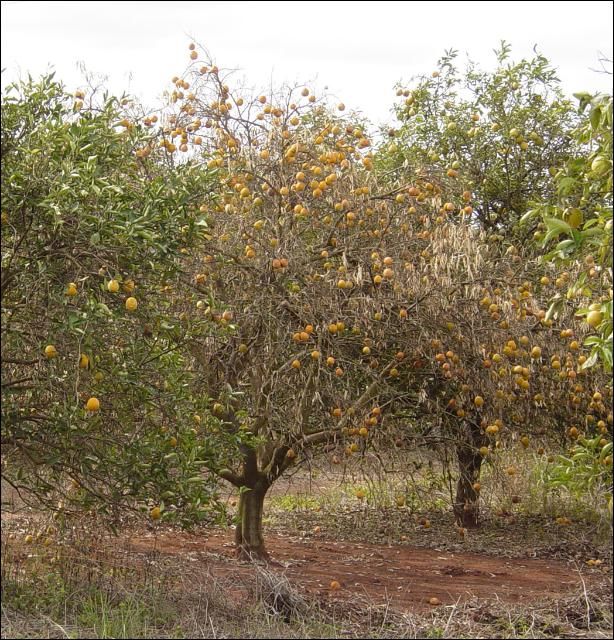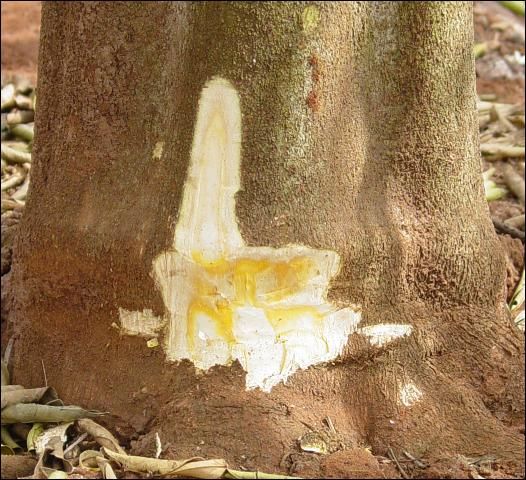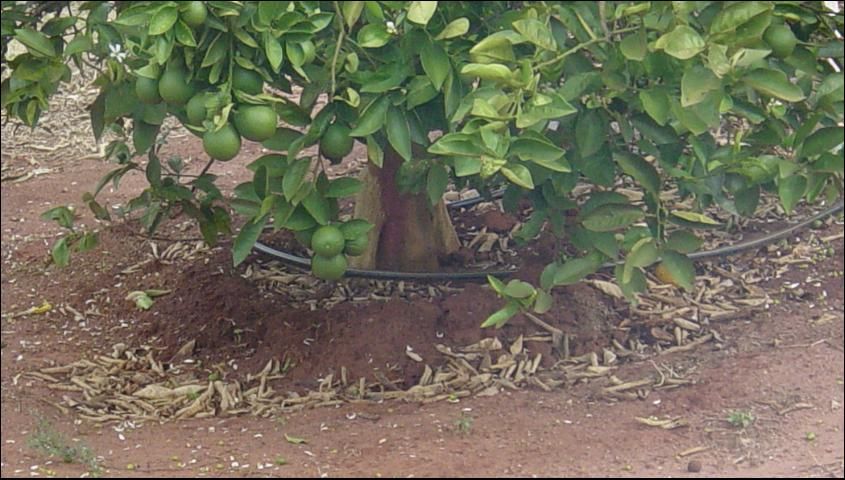Citrus sudden death is a relatively new disease to Brazil, first confirmed as a problem in 1999. The disease was first reported in the northern part of the citrus production area located in the state of Minas Gerais and has since spread into the northern part of Sao Paulo State, which is the largest citrus-producing state in Brazil. This northern citrus production region has a hotter climate and is subject to greater moisture stress than the majority of Sao Paulo State. The cause of the disease is presently unknown, but it appears to be an infectious disease that affects trees budded on Rangpur lime with limited reports on Volkamer lemon being infected.
Trees affected with sudden death decline rapidly within weeks of initial visual symptoms, and the disease has been give the name "sudden death" or in Portuguese "morte subita dos citros" (Figure 1). To date millions of trees have been reported lost due to the disease.

Most of the major cultivars, including Valencia, Natal, Pera, Hamlin, Westin, Pineapple and mandarins were found infected.
At the present time, sudden death appears to affect only trees on Rangpur lime and to a lesser extent on Volkamer lemon. As a large part of Brazil's citrus industry planted on Rangpur lime rootstock, this poses a significant threat to their industry.
Sudden death causes a general but usually quick decline of the tree with a significant reduction in fibrous roots and a yellow stain in the bark (Figure 2) when thinly sliced from the lower trunk portion of the tree. The yellow stain is located in the phloem of the bark. Trees infested with sudden death will have fruit of normal size as compared to other diseases that cause fruit to be smaller than normal. Some have suggested that, based upon the spread pattern, an insect vector may be involved in the movement of the disease, but this has not been proven.

Strategies To Combat Citrus Sudden Death
Since it appears that the disease mainly affects trees on Rangpur lime, citrus growers are switching to rootstocks that appear to tolerate the disease in currently infested locations. Tolerant rootstocks currently being used include Swingle citrumelo, Cleopatra mandarin, Sunki mandarin and trifoliate orange. However, the problem with switching to other rootstocks is that these alternative rootstocks are not as tolerant of the extreme drought conditions that appear in the fall and winter seasons in Brazil. With the movement to other rootstocks, growers are increasingly being forced to use irrigation to minimize the drought effects. This adoption of irrigation increases their grove establishment costs as well as the annual production costs. Water is limited and expensive due to expenses associated with irrigation well drilling depths.
An additional method of coping with the disease is the use of inarching with a tolerant rootstock on trees less than three to five years old and planted on Rangpur lime rootstock. Inarching is a process whereby a small seeding is planted near the trunk of the tree and grafted into the established tree above the budunion (Figure 3). Over a period of time, this new tolerant rootstock will grow and aid in replacing the old root system being affected by the sudden death. While inarching has shown some success, it is mainly limited to trees less than three to five years old that are free of visible disease problems. Trees greater than five years of age have died when inarched with a tolerant rootstock even when the trees were apparently free of the disease at the time of inarching. Inarching does add an additional cost of approximately $1.00 to $1.40 per inarch tree, and since it is suggested to place two inarchings per tree, the total added cost for this process comes to $1.00 to $2.80 per tree. Inarching is most successful when done during Brazil's rainy season to aid in the establishing of the new root system of the new tree.

Another recommendation is to use budwood grown in areas free of sudden death. Additionally, nursery trees are required to be produced in enclosed structures to control citrus variegated chlorosis, which may limit the spread of sudden death.